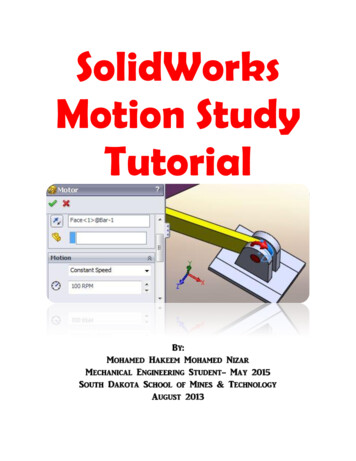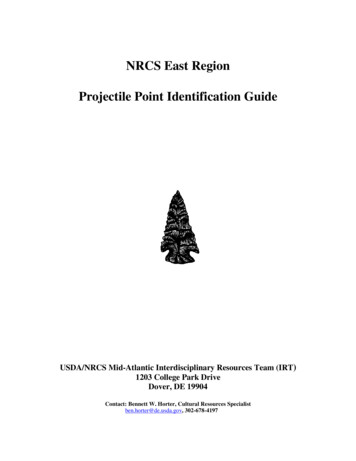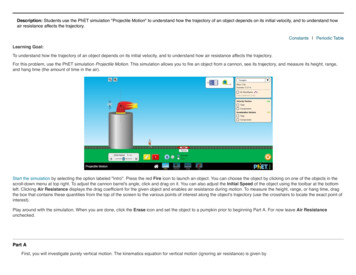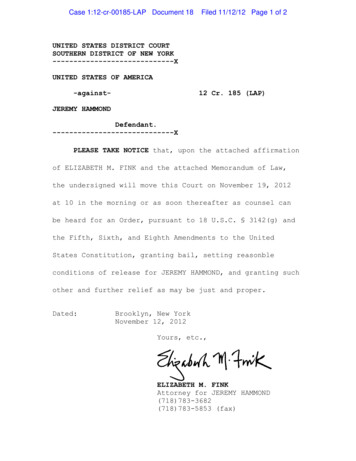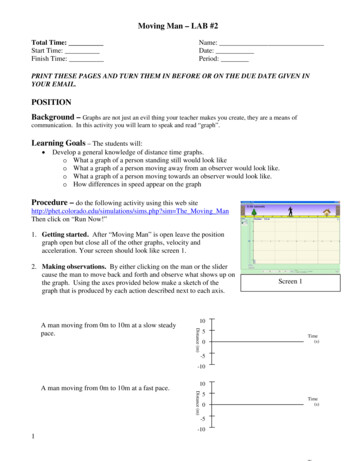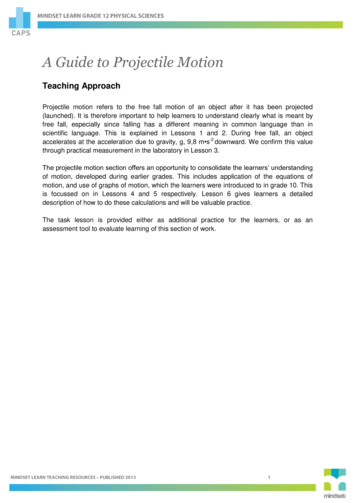
Transcription
A Guide to Projectile MotionTeaching ApproachProjectile motion refers to the free fall motion of an object after it has been projected(launched). It is therefore important to help learners to understand clearly what is meant byfree fall, especially since falling has a different meaning in common language than inscientific language. This is explained in Lessons 1 and 2. During free fall, an objectaccelerates at the acceleration due to gravity, g, 9,8 m s-2 downward. We confirm this valuethrough practical measurement in the laboratory in Lesson 3.The projectile motion section offers an opportunity to consolidate the learners’ understandingof motion, developed during earlier grades. This includes application of the equations ofmotion, and use of graphs of motion, which the learners were introduced to in grade 10. Thisis focussed on in Lessons 4 and 5 respectively. Lesson 6 gives learners a detaileddescription of how to do these calculations and will be valuable practice.The task lesson is provided either as additional practice for the learners, or as anassessment tool to evaluate learning of this section of work.
Video SummariesSome videos have a ‘PAUSE’ moment, at which point the teacher or learner can choose topause the video and try to answer the question posed or calculate the answer to the problemunder discussion. Once the video starts again, the answer to the question or the right answerto the calculation is givenMindset suggests a number of ways to use the video lessons. These include: Watch or show a lesson as an introduction to a lesson Watch or show a lesson after a lesson, as a summary or as a way of adding in someinteresting real-life applications or practical aspects Design a worksheet or set of questions about one video lesson. Then ask learners towatch a video related to the lesson and to complete the worksheet or questions, either ingroups or individually Worksheets and questions based on video lessons can be used as short assessments orexercises Ask learners to watch a particular video lesson for homework (in the school library or onthe website, depending on how the material is available) as preparation for the next day’slesson; if desired, learners can be given specific questions to answer in preparation forthe next day’s lesson1. Downward Free FallWe focus on the basic concepts and sample data for an object moving downward while infree fall. An object is in free fall when its weight is the only significant vertical force actingon it. It is then called a projectile.2. Upward and Downward Free FallThis is a lesson on free fall. In scientific language an object can be falling when it ismoving upward, downward, or stationary for an instant at the top of its motion.3. Practical Confirmation of the Value of ‘g’, the Acceleration Due to GravityThis lesson confirms the value of the acceleration due to gravity, g, as 9,8 m s -2. A ball isdropped past a motion detector which measures its initial and final velocities as it falls adistance of 0,5 m.4. Equations of Motion and Free FallIn this lesson we practice using the equations of motion to solve projectile motionproblems.5. Graphing Free Fall IIn this lesson we draw position-time, velocity-time and acceleration-time graphs forprojectile motion.6. Graphing Free Fall IIWe’ve drawn graphs for a projectile moving downward. In this lesson we draw graphs of aprojectile moving both up and down.
7. CalculationsIn this lesson we work through some calculations about 1-dimensional projectile motion.8. Calculations with GraphsIn this lesson we will look at some questions related to two graphs of motion.
Resource Material1. Downward Free Fall2. UpwardFree FallandDownward3. Practical Confirmation ofthe Value of ‘g’, theAcceleration Due to Gravityhttp://www.youtube.com/watch?v ndFXXasM6ZEA ball and a feather fall together in avacuum ile-motion-downA PowerPoint on SlideShare, withmany of the graphics and text usedin the video.http://www.youtube.com/watch?v b3Cv2WTwZakFootage from the moon. Anastronaut drops a feather and ahammer at the same moment. Theyhit the moon’s surface at the sametime because they are both in freefall, since there is no atmosphere toprovide air resistance on the his link leads to the contents pagefor 1-D kinematics for The PhysicsClassroom. This contains manylinks, each of which leads to clear,concise explanations of an aspect of1-D kinematics. These explanationsareclearlyandattractivelyillustrated, include worked examples,and have links to other usefulresources for learners and ctors/mzi.cfmA simulation of what would happen ifa person threw a banana at amonkey:Inagravity-freeenvironment, on Earth, and onplanets with stronger or weakerforces of gravity than tile-motion-upanddownA PowerPoint on SlideShare, withmany of the graphics and text usedin the ceover-7716/A video showing an alternative wayof measuring acceleration due togravity, g, using a dfA worksheet with instructions on howto measure acceleration due togravity, g, using a pendulum, andquestions to guide teachers andlearners through this practical.https://www.google.co.za/url?sa t&rct j&q &esrc s&source web&cd 1&ved 0CCwQFjAA&url http%3AA Word document containinginstructions on how to measure thevalue of the acceleration due to
4. Calculations forPhotoelectric Effect5. Graphing Free Fall I6. Graphing Free Fall II7. 4%2FMechanics%2FMotion%2Fexperiments%2Fgravity ticker timer.doc&ei JO1nUs3GJ6A7QblzYGgAQ&usg AFQjCNH0FLFyvL0XXBvpczmIdQYjZQUIA&sig2 yztWBgeJ9E3ZbCnl56BhQ&bvm bv.55123115,d.ZGUgravity, g, using a v/projectile-motion--part-1A video showing a worked examplefor 1-D vertical projectile motion fromthe Khan Academy. There are 5parts to this series, so learners canclick on the links to the next parts s/one-dimensionalmotion/kinematic formulas/v/projectile-height-given-timeA video showing a worked examplefor 1-D vertical projectile motion fromthe Khan Academy. The height aprojectile reaches is calculated frominformation about the time of theprojectile’s motion. There are twoother relevant videos (‘Deriving MaxProjectile Displacement Given Time’and ‘Impact Velocity From GivenHeight’) which can also be accessedfrom this tile-motionA sions02.cnxmlplusText from Siyavula’s free grade 12physical science textbook. Includesa number of worked examples usingequations and graphs of motion for1-D vertical projectile /one-dimensionalmotion/kinematic eration-and-velocityA video from the Khan Academy inwhich position-time, velocity-timeand acceleration-time graphs aredrawn for 1-D vertical tott/projectile-motionequationsofmotionA slideshare PowerPoint containingmost of the questions and graphicsused in this video.simulationofprojectile
8. Calculations with Stott/projectile-motion-graphsA slideshare PowerPoint containingmost of the questions and graphicsused in this video.
TaskQuestion 1Refer to the following velocity-time graph of a projectile to answer these questions:1.1 State whether each of the following statements is true or false. If false, correct thestatement:1.1.1 This projectile’s velocity is constant.1.1.2 This projectile’s acceleration is positive.1.1.3 This projectile’s acceleration is constant.1.1.4 The downward direction is taken as positive for this graph.1.1.5 This graph shows that the projectile moves downward, hits the ground andbounces up.1.2 Which one of these graphs represents the acceleration-time graph which corresponds tothe motion of this projectile?ABCD
Question 2Refer to the following position-time graph of a bouncing ball to answer these questions.Ignore air resistance.h0,350,317 0,3422.12.22.32.42.5tCalculate the height (h) the ball was dropped from.What was the velocity of the ball the moment before it hit the ground (time 0,317 s)?What was the velocity of the ball the moment after it left the ground (time 0,342 s)?What was the velocity of the ball at time t?When the ball is at maximum height (times 0 and t), is its acceleration upward,downward or zero?Question 3An object is projected vertically upwards at 5 m s-1 from the roof of a building which is 830 mhigh. It strikes a balcony below after 8 s. The object then bounces off the balcony and strikesthe ground as illustrated below. Ignore the effects of friction.5 m s-1830 m
3.1 Calculate the:3.1.1 Velocity at which the object strikes the balcony3.1.2 Height, h, of the balcony above the ground.3.2 The object bounces off the balcony at a velocity of 60 m s-1 and strikes the ground18,4 s after it leaves the balcony.Sketch a velocity-time graph to represent the motion of the object from the moment it isprojected from the ROOF of the building until it strikes the GROUND. (Note: The sketchdoes not need to be to scale). Indicate the following velocity and time values on thegraph: The initial velocity at which the object was projected from the roof of the building The velocity at which the object strikes the balcony The time when the object strikes the balcony The velocity at which the object bounces off the balcony The time when the object strikes the ground
Task AnswersQuestion 11.11.1.11.1.21.1.31.1.41.1.5False. The projectile’s velocity increased constantly.True.True.True.False. The graph shows the projectile moving upward, reaching maximum height and zerovelocity, and then moving downward.1.2 BQuestion 2Let upward be positive22.1 y vi t ½ a t2y 0(0,317) ½ (-9,8) 0,317)y 0 – 0,49y – 0,49 mThe ball moves 0,49 m downward during the first 0,317 s. Therefore, the height, h, is 0,49 mabove the ground.2.2 vf vi a tvf 0 (-9,8) (0,317)-1vf -3,1 m s-1vf 3,1 m s downward222.3 vf vi 2a y20 vi 2(-9,8)(0,35)2-vi - 6,862vi 6,86vi -1vi 2,62 m s upward-12.4 0 m s2.5 DownwardQuestion 3Let upward be positive3.13.1.1 vf vi a tvf 5 (-9,8)(8)-1vf 5 - 78,4 m s-1vf -73,4 m s downward23.1.2y vi t ½ a t2y 5(8) ½ (-9,8)(8)y 40 - 313,6y - 273,6 mSo the ball hits the balcony 273,6 m below its starting point, which was 830 m above theground, therefore the balcony is (830 – 273,6) m above the ground.So the balcony is 556,4 m above the ground.
3.2
AcknowledgementsMindset Learn Executive HeadContent Manager Classroom ResourcesContent Coordinator Classroom ResourcesContent AdministratorContent DeveloperContent ReviewersDylan BusaJenny LamontHelen RobertsonAgness MunthaliAngela StottLiz HarrisDawn ClarkProduced for Mindset Learn by TrafficFacilities CoordinatorProduction ManagerDirectorEditorPresenterStudio CrewGraphicsCezanne ScheepersBelinda RenneyAlriette GibbsNonhlanhla NxumaloPatrick ShabanguAbram TjaleJames TselapediWilson MthembuWayne SandersonCreditsThis resource is licensed under a Attribution-Share Alike 2.5 South Africa mons
1. Downward Free Fall We focus on the basic concepts and sample data for an object moving downward while in free fall. An object is in free fall when its weight is the only significant vertical force acting on it. It is then called a projectile. 2. U



